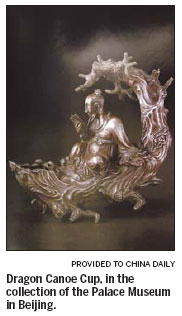Heritage
A cup that cheered the spirit
Updated: 2011-07-05 07:58
By Cheng Anqi (China Daily)

EDITOR's Note: Every week we look at a work of art or a cultural relic that puts the spotlight on China's heritage.
Ever since Du Kang of the Xia Dynasty (c.21st century-16th century BC) first invented white liquor, Chinese wine sets have come in a range of shapes and sizes.
As kings and nobles became addicted to liquor this variety only got richer.
The silver wine vessels of ancient China were magnificent works of art churned out by master craftsmen.
An exquisite example of this is Dragon Canoe Cup (Long Cha Bei) created by Zhu Bishan, a silversmith of the Yuan Dynasty (1271-1368).
The canoe-shape vessel - 18 cm high and 20 cm wide - depicts a Taoist priest sitting on a tree and reading a book in utter concentration.
The graceful figure evokes images of ancient Chinese scholars engaged in the pursuit of a higher meaning in life.
According to Zhang Rong, senior antiquities researcher of the Palace Museum, this masterpiece not only offers a glimpse into Zhu's artistic achievements but also reflects the high standards of silver casting in the Yuan period.

In this case, the wine cup was cast first and then engraved with details.
The head, hands and shoes of the priest were welded on to the body at a later stage, but there is hardly any trace of a joint anywhere. The whole piece looks like it was cast in one mould.
Zhu drew his inspiration for this vessel from the legend of a celestial being who flew to the heavens in a canoe.
It was much coveted by the royals and nobles, who recorded their ownership of it by inscribing poems on it.
Two characters, long and cha, are engraved at the tail end of the craft.
Below the mouth of the cup, neatly inscribed in running script, are these words by Du Ben, a litterateur of the Qing Dynasty (1644-1911):
To hold good wine for your own enjoyment, to float over the Milky Way and go on high.
Although Zhu made many such silver vessels, only four remain in existence today.
Beside the Dragon Canoe Cup housed in the Palace Museum, there is one in the possession of the antiques management committee in Wuxian village of East China's Jiangsu province, another in the Taipei Palace Museum and a third with the Cleveland Museum of Art in the United States.
China Daily
E-paper

Shining through
Chinese fireworks overcome cloudy times, pin hopes on burgeoning domestic demand
Pen mightier than the sword
Stroke of luck
Romance by the sea
Specials

90th anniversary of the CPC
The Party has been leading the country and people to prosperity.

My China story
Foreign readers are invited to share your China stories.

Green makeover
Cleanup of Xi'an wasteland pays off for ancient city
